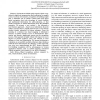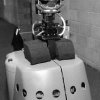88 search results - page 12 / 18 » Visual Navigation for Mobile Robots: A Survey |
ICRA
2005
IEEE
14 years 1 months ago
2005
IEEE
Abstract— Autonomous mobile agents require object recognition for high level interpretation and localization in complex scenes. In urban environments, recognition of buildings mi...
FLAIRS
2006
13 years 8 months ago
2006
Autonomous robots, such as automatic vacuum cleaners, toy robot dogs, and autonomous vehicles for the military, are rapidly becoming a part of everyday life. As a result the need ...
AROBOTS
1999
13 years 7 months ago
1999
Sensing visual motion gives a creature valuable information about its interactions with the environment. Flies in particular use visual motion information to navigate through turbu...
IROS
2008
IEEE
14 years 1 months ago
2008
IEEE
— A mobile robot operating in an urban environment has to navigate around obstacles and hazards. Though a significant amount of work has been done on detecting obstacles, not mu...
CVPR
1999
IEEE
14 years 9 months ago
1999
IEEE
To navigate reliably in indoor environments, a mobile robot must know where it is. This includes both the ability of globally localizing the robot from scratch, as well as trackin...


